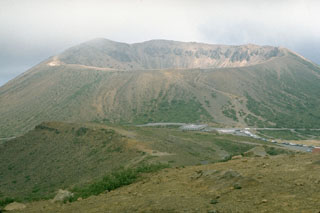Report on Azumayama (Japan) — January 1978
Scientific Event Alert Network Bulletin, vol. 3, no. 1 (January 1978)
Managing Editor: David Squires.
Azumayama (Japan) Small ash ejection in December
Please cite this report as:
Global Volcanism Program, 1978. Report on Azumayama (Japan) (Squires, D., ed.). Scientific Event Alert Network Bulletin, 3:1. Smithsonian Institution. https://doi.org/10.5479/si.GVP.SEAN197801-283180
Azumayama
Japan
37.735°N, 140.244°E; summit elev. 1949 m
All times are local (unless otherwise noted)
The number of volcanic earthquakes at Azuma, including some felt events, began to increase in September and continued at an increased rate in October. On 26 October, the fume cloud rose about 400 m from Oana Crater on the SE flank of Issaikyo, one of the numerous stratovolcanoes that comprise the Azuma complex. Mud and sand spattering began, and fist-sized blocks were thrown 20 m above the crater. Active fuming continued through November.
A brief eruption from Oana was observed during the early morning of 7 December from Fukushima Meteorological Observatory, about 20 km to the E. The ash cloud rose 500-1,000 m above the crater and produced a slight ashfall nearby. Similar ash ejections occurred through the end of December.
Geological Summary. The Azumayama volcanic group consists of a cluster of stratovolcanoes, shield volcanoes, lava domes, and pyroclastic cones. The andesitic and basaltic complex was constructed in two E-W rows above a relatively high basement of Tertiary sedimentary rocks and granodiorites west of Fukushima city. Volcanic activity has migrated to the east, with the Higashi-Azuma volcano group being the youngest. The symmetrical Azuma-Kofuji crater and a nearby fumarolic area on the flank of Issaikyo volcano are popular tourist destinations. The Azumayama complex contains several crater lakes, including Goshikinuma and Okenuma. Historical eruptions, mostly small phreatic explosions, have been restricted to Issaikyo volcano at the northern end of the Higashiyama group.
Information Contacts: JMA, Tokyo; Y. Sawada, Meteorological Research Institute, Tokyo; D. Shackelford, USA.

